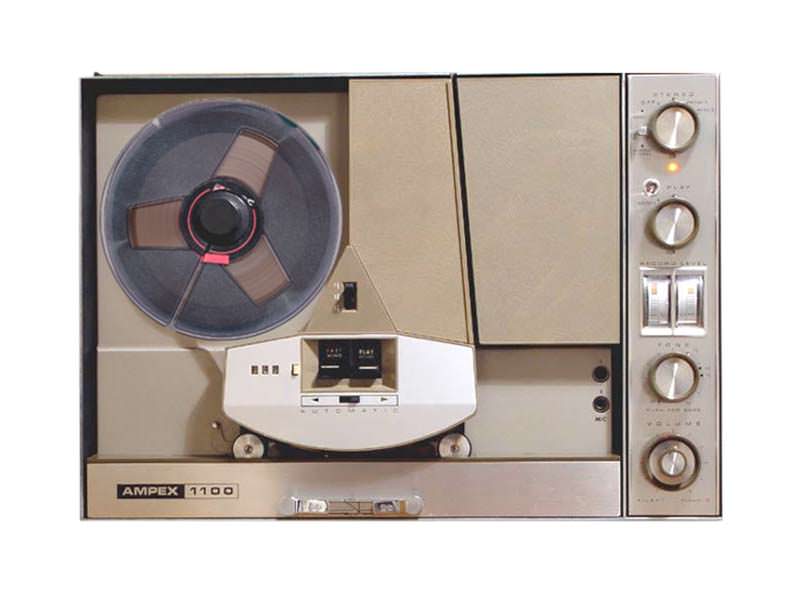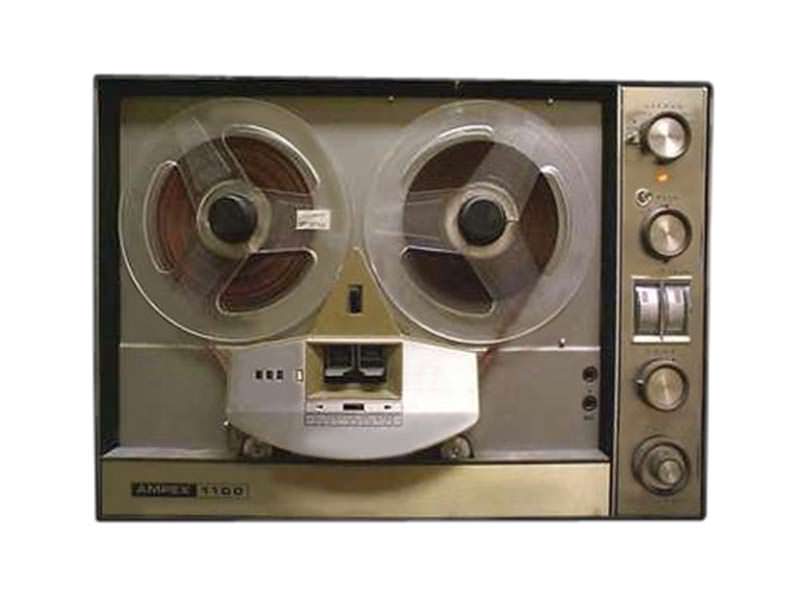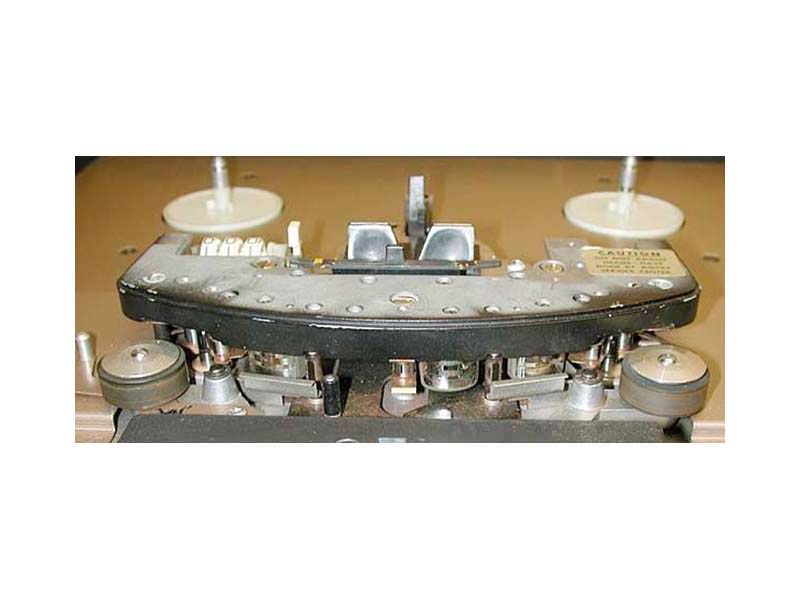Technical Details
Brand: Ampex
Model:1100 series
Category:Mid High Fidelity
Application:Consumer
Electronics:Solid State
Equalization:NAB
Country of Manufacture:USA
Release dates:1966 - 1969
Tracks:1/4 Rec/PB
Speeds: 1 7/8, 3 3/4, 7 1/2
Max Reel Size("): 7"
Number of heads: 2
Head Composition: Permalloy
Head Configuration: Stereo
# Motors: 1
Auto Reverse?:Yes
Voltage(s): 110-120v
Outputs: RCA
Frequency Response:(all 3 dB): 7½ ips: 50 to 15kHz
Wow and Flutter:0.2% at 1, 0.12% at 3¾ and 0.08% at 7½ ips
Signal-to-Noise Ratio:43dB at 1, 48dB at 3¾ and 53dB at 7½ ips
Sound quality rating:6 / 10
Long-term reliability rating: 6/ 10
Additional Details
Description
A single motor, three speed all-solid-state recorder built to professional standards with automatic
threading and auto-reverse facility.
The tape was led round the curved face of the head block and dropped into a straight slot which ran from the top to the bottom of the box-like casing that replaced the take-up reel on the right hand side of the recorder. Inside this box was a single flanged spool with a castellated hub which grabbed the tape and began winding it without any further assistance. The right hand reel could be replaced with a conventional type (top left) or using the enclosed auto-takeup arrangement.
Additional Info
Rewind speed: 1 minute 55 seconds for 1200ft / Audio output power: 6 watts per channel (model 1163) / Weight: model 1152 – 27lb, model 1163 – 39lb / quarter-track stereo
Ampex 1150 – Amateur Tape Recording, January 1967
In all my experience of handling and using tape recorders and tape record/replay units, I have never come across any quite like the Ampex 1100 Series. There are actually three versions, more or less identical, and like the Model 1150 (the subject of this review) are tape record/replay units only. The other two are the 1160 and 1165, both of which are built into cabinets – the 1165 having a case with a walnut finish. (Note: the 1160 and 1165 units each have power output stages; the 1150 model therefore requires external amplifiers and loudspeakers. The other two require external speakers only.)
These units are, to say the least, unique and almost entirely automatic, but first you must read the very detailed instruction book very thoroughly. Then, having mastered the controls you can sit back and let this highly automated box of electronics do the work for you. For instance, to load up a four-track pre-recorded stereo tape, insert the leader in the slot on the right, press the appropriate button and the tape will play through to the end whereupon it will reverse itself (on direction) and play through the other two tracks. When the tape comes to the end, the drive mechanism will be switched off and the direction changeover system automatically re-set for the next tape. All that is required to do this is the recording of special low frequency signals at the end of side 1 of the tape – this facility is built into the recorder. By this means all your tapes can, in fact, be signal coded to automatically reverse. But the automation does not end there; the reverse direction signals can be recorded anywhere along a length of tape so one can replay a short piece backwards and forwards ad lib. I set up the system to play in both directions over about 12 inches of tape and left it running for quite a few hours. The electronics and the mechanism worked quite happily and without fault.
Another novel aspect of the automation is that for normal recording and playback usage (when the special right-hand spool is replaced with an ordinary one) the machine always resets itself for the correct direction of wind, rewind or record/replay. For example, if you play part of a tape (left to right) rewind and to play again, the replay direction will automatically be re-set. Because of this, only one button has to be used for what would otherwise involve three separate functions.
Technical Details
So much for the automation. The 1100 Series are, however, more than just electronic ‘robots’ capable of playing pre-recorded tapes backwards and forwards. These units do function as ‘normal’ tape recorders (except for the output stages and loudspeaker). The special spool, which is normally hidden by the slotted cover, can be removed (together with the cover) and an ordinary seven inch spool put on. The machine is then ready to function for recording, playing, rewinding and editing in the more conventional manner, except that the automatic direction re-set system still functions.
For general recording there are two microphone inputs, one for each channel (yes, I did forget to mention that this is a quarter-track stereo recorder), and similarly two high-level (radio) signal inputs. The microphone sockets are on the front panel. There are two high-level signal output sockets (one for each channel) each of which are preceded by ganged volume controls. The same controls come into operation for adjusting level when recording, but can be adjusted individually on playback or record. On playback both channels are ‘tone controlled’ or more correctly, have a variable control for playback treble boost or cut relative to the playback speed. Any small loss in upper frequency response can be compensated on replay.
The next control above the twin VU type recording level meters takes care of replay function and incorporates a safety lock against accidental recording over an already recorded tape. Above this is the ‘automation’ control which is used for recording the reverse coding signals on to a tape and/or selecting automatic re-run or ‘repeat’, i.e., playing backwards and forwards over any length of tape.
The 1100 Series arc all quarter-track stereo models and are for three speeds, namely 7½, 3¾ and 1 7/8 ips. Other deck features are a three-figure tape position indicator and an illuminated recording button (lights red when recording). Perhaps the most important feature is that the deck can be operated vertically or horizontally and so could stand on a bookshelf.
Technical Performance
The Ampex 1100 Series were designed as ‘hi-fi’ recording and playing units and are fully transistorized (solid state is the American term used by Ampex). The performance specification quotes the frequency response as 50-15,000c/s ±4 dB at 7½ ips, and 50-7,500c/s ±4 dB at 3¾ ips. The replay tone control provides a 6dB lift at l00c/s and a : l0dB cut or lift at 10,000c/s. Wow and flutter are 0.15% at 7½ ips and 0.2% at 3¾ ips. Speed accuracy comes out to within 2% at 7½ ips and 3% at 3¾ ips. To quote from the Ampex Instruction Book:
The tape recorder industry today is in a horsepower race and there is no standard procedure for obtaining and stating specifications. Therefore if you wish to compare Ampex spec$ specifications with those of any other competitor you must make sure that those specifications were obtained under similar conditions. Other wise no valid conclusions or comparison can be obtained. For this reason, Ampex has chosen not to show specifications of the 1100 Series at 1 7/8 ips. The speed is not recommended for music recording. The Ampex 1100 Series out-perform any other recorder/player within its price range at 17/8 ips. We invite your comparison. Ampex is proud of the specification of its tape recorders. Throughout the years Ampex tape recorders have set the pace for the industry and commanded the biggest in trade values. They will continue to do so.
Well, there’s nothing like being honest and I think Ampex are to be congratulated on this. So I should therefore add that at the two higher recording speeds, namely 7½ and 3¾ ips, the performance is more than adequate for hi-fi. To refer to those about to throw bricks at my Editorial Comment h the November: edition of ATR – how many quarter-track tape recorders will record faithfully at frequencies above 7,500c/s at 3¾ ips without excessive noise and distortion due to the high recording pre-emphasis. I used the Ampex 1150 as its quoted specifications intended it to be used and it far exceeded my expectations. Half the pre-recorded tapes I tried on it couldn’t begin to do justice to the machine, even at 7½ ips, and I had it coupled to one of the finest hi-fi outfits on the market today. So much for its performance as a replay recorder. Now, what of recording? Most readers know of my multi-recording activity, so here, I thought, was a good test for signal to noise and recording performance. Let me explain that these Ampex units are not geared for multi-recording, i.e., track to track, so I used the 1150 in conjunction with a professional full-track machine. As I expected, the Ampex produced a good healthy recording after four or five dubbings without any build-up, hum or noise.
Finally, I must make it clear that this is a review and not a technical test report on what I consider a rather unique piece of hi-fi equipment. The Ampex 1150 or its sister models are not really intended for the creative enthusiast who would prefer a machine with mixing facilities, etc. They are, however, ideal for the hi-fi man who will want to do straight recording from music sources, play pre-recorded tapes and occasionally venture into the rather more sophisticated realms of the editing and splicing fraternity. For those who may be interested in either of the three 1100 models now available, the Ampex specification is given in a separate panel.
Note no accessories such as tape or microphones are included with the 1100 series. The retail price of the 1150 model is £149 10s. Prices of the other units and further details can be obtained from Ampex (Great Britain) Ltd, Acre Road, Reading, Berks.
by F.C.Judd
Reviews
Ampex 1150 - Amateur Tape Recording, January 1967
In all my experience of handling and using tape recorders and tape record/replay units, I have never come across any quite like the Ampex 1100 Series. There are actually three versions, more or less identical, and like the Model 1150 (the subject of this review) are tape record/replay units only. The other two are the 1160 and 1165, both of which are built into cabinets - the 1165 having a case with a walnut finish. (Note: the 1160 and 1165 unit




